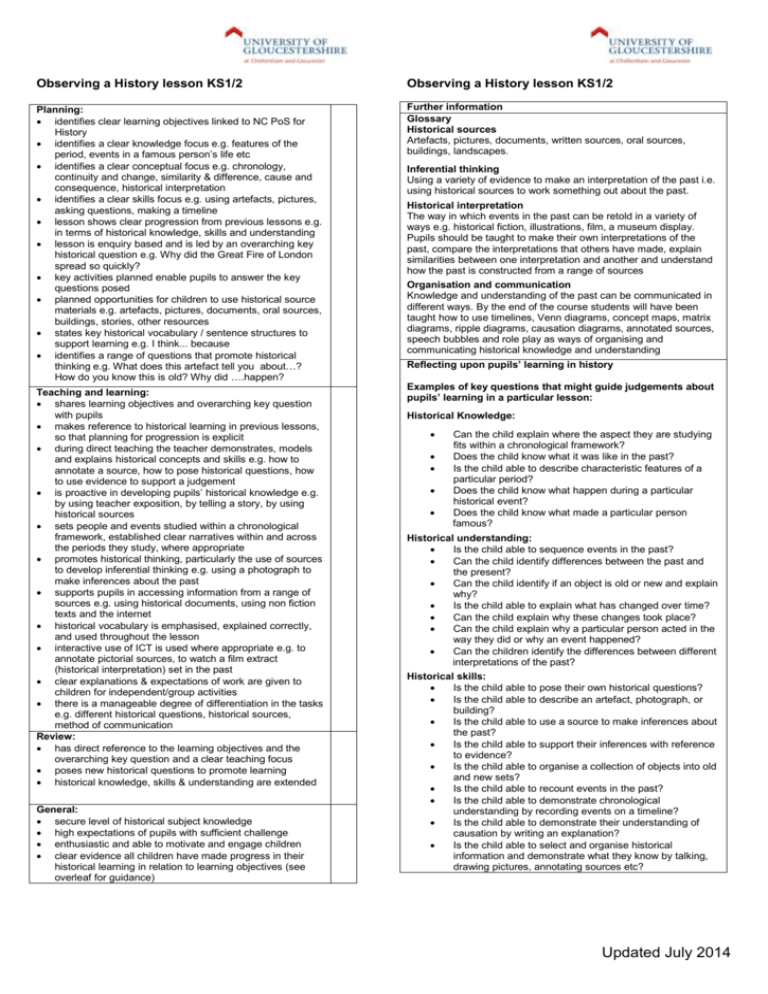History Bookmark 2014
advertisement

Observing a History lesson KS1/2 Observing a History lesson KS1/2 Planning: identifies clear learning objectives linked to NC PoS for History identifies a clear knowledge focus e.g. features of the period, events in a famous person’s life etc identifies a clear conceptual focus e.g. chronology, continuity and change, similarity & difference, cause and consequence, historical interpretation identifies a clear skills focus e.g. using artefacts, pictures, asking questions, making a timeline lesson shows clear progression from previous lessons e.g. in terms of historical knowledge, skills and understanding lesson is enquiry based and is led by an overarching key historical question e.g. Why did the Great Fire of London spread so quickly? key activities planned enable pupils to answer the key questions posed planned opportunities for children to use historical source materials e.g. artefacts, pictures, documents, oral sources, buildings, stories, other resources states key historical vocabulary / sentence structures to support learning e.g. I think... because identifies a range of questions that promote historical thinking e.g. What does this artefact tell you about…? How do you know this is old? Why did ….happen? Further information Glossary Historical sources Artefacts, pictures, documents, written sources, oral sources, buildings, landscapes. Teaching and learning: shares learning objectives and overarching key question with pupils makes reference to historical learning in previous lessons, so that planning for progression is explicit during direct teaching the teacher demonstrates, models and explains historical concepts and skills e.g. how to annotate a source, how to pose historical questions, how to use evidence to support a judgement is proactive in developing pupils’ historical knowledge e.g. by using teacher exposition, by telling a story, by using historical sources sets people and events studied within a chronological framework, established clear narratives within and across the periods they study, where appropriate promotes historical thinking, particularly the use of sources to develop inferential thinking e.g. using a photograph to make inferences about the past supports pupils in accessing information from a range of sources e.g. using historical documents, using non fiction texts and the internet historical vocabulary is emphasised, explained correctly, and used throughout the lesson interactive use of ICT is used where appropriate e.g. to annotate pictorial sources, to watch a film extract (historical interpretation) set in the past clear explanations & expectations of work are given to children for independent/group activities there is a manageable degree of differentiation in the tasks e.g. different historical questions, historical sources, method of communication Review: has direct reference to the learning objectives and the overarching key question and a clear teaching focus poses new historical questions to promote learning historical knowledge, skills & understanding are extended General: secure level of historical subject knowledge high expectations of pupils with sufficient challenge enthusiastic and able to motivate and engage children clear evidence all children have made progress in their historical learning in relation to learning objectives (see overleaf for guidance) Inferential thinking Using a variety of evidence to make an interpretation of the past i.e. using historical sources to work something out about the past. Historical interpretation The way in which events in the past can be retold in a variety of ways e.g. historical fiction, illustrations, film, a museum display. Pupils should be taught to make their own interpretations of the past, compare the interpretations that others have made, explain similarities between one interpretation and another and understand how the past is constructed from a range of sources Organisation and communication Knowledge and understanding of the past can be communicated in different ways. By the end of the course students will have been taught how to use timelines, Venn diagrams, concept maps, matrix diagrams, ripple diagrams, causation diagrams, annotated sources, speech bubbles and role play as ways of organising and communicating historical knowledge and understanding Reflecting upon pupils’ learning in history Examples of key questions that might guide judgements about pupils’ learning in a particular lesson: Historical Knowledge: Can the child explain where the aspect they are studying fits within a chronological framework? Does the child know what it was like in the past? Is the child able to describe characteristic features of a particular period? Does the child know what happen during a particular historical event? Does the child know what made a particular person famous? Historical understanding: Is the child able to sequence events in the past? Can the child identify differences between the past and the present? Can the child identify if an object is old or new and explain why? Is the child able to explain what has changed over time? Can the child explain why these changes took place? Can the child explain why a particular person acted in the way they did or why an event happened? Can the children identify the differences between different interpretations of the past? Historical skills: Is the child able to pose their own historical questions? Is the child able to describe an artefact, photograph, or building? Is the child able to use a source to make inferences about the past? Is the child able to support their inferences with reference to evidence? Is the child able to organise a collection of objects into old and new sets? Is the child able to recount events in the past? Is the child able to demonstrate chronological understanding by recording events on a timeline? Is the child able to demonstrate their understanding of causation by writing an explanation? Is the child able to select and organise historical information and demonstrate what they know by talking, drawing pictures, annotating sources etc? Updated July 2014



![afl_mat[1]](http://s2.studylib.net/store/data/005387843_1-8371eaaba182de7da429cb4369cd28fc-300x300.png)




